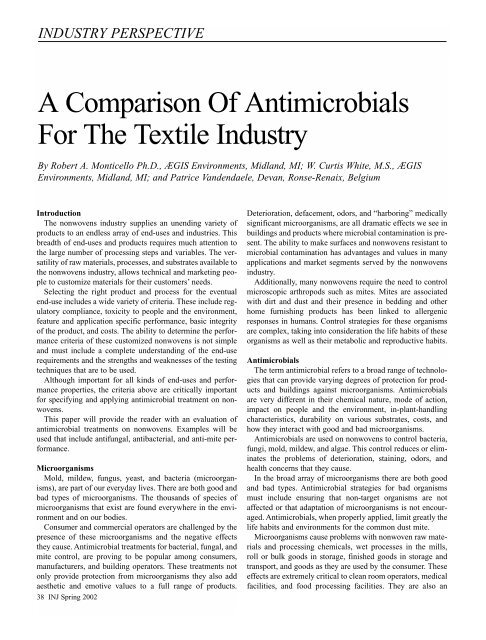2002 - Volume 1 - JEFF. Journal of Engineered Fibers and Fabrics
2002 - Volume 1 - JEFF. Journal of Engineered Fibers and Fabrics
2002 - Volume 1 - JEFF. Journal of Engineered Fibers and Fabrics
Create successful ePaper yourself
Turn your PDF publications into a flip-book with our unique Google optimized e-Paper software.
INDUSTRY PERSPECTIVE<br />
A Comparison Of Antimicrobials<br />
For The Textile Industry<br />
By Robert A. Monticello Ph.D., ÆGIS Environments, Midl<strong>and</strong>, MI; W. Curtis White, M.S., ÆGIS<br />
Environments, Midl<strong>and</strong>, MI; <strong>and</strong> Patrice V<strong>and</strong>endaele, Devan, Ronse-Renaix, Belgium<br />
Introduction<br />
The nonwovens industry supplies an unending variety <strong>of</strong><br />
products to an endless array <strong>of</strong> end-uses <strong>and</strong> industries. This<br />
breadth <strong>of</strong> end-uses <strong>and</strong> products requires much attention to<br />
the large number <strong>of</strong> processing steps <strong>and</strong> variables. The versatility<br />
<strong>of</strong> raw materials, processes, <strong>and</strong> substrates available to<br />
the nonwovens industry, allows technical <strong>and</strong> marketing people<br />
to customize materials for their customers’ needs.<br />
Selecting the right product <strong>and</strong> process for the eventual<br />
end-use includes a wide variety <strong>of</strong> criteria. These include regulatory<br />
compliance, toxicity to people <strong>and</strong> the environment,<br />
feature <strong>and</strong> application specific performance, basic integrity<br />
<strong>of</strong> the product, <strong>and</strong> costs. The ability to determine the performance<br />
criteria <strong>of</strong> these customized nonwovens is not simple<br />
<strong>and</strong> must include a complete underst<strong>and</strong>ing <strong>of</strong> the end-use<br />
requirements <strong>and</strong> the strengths <strong>and</strong> weaknesses <strong>of</strong> the testing<br />
techniques that are to be used.<br />
Although important for all kinds <strong>of</strong> end-uses <strong>and</strong> performance<br />
properties, the criteria above are critically important<br />
for specifying <strong>and</strong> applying antimicrobial treatment on nonwovens.<br />
This paper will provide the reader with an evaluation <strong>of</strong><br />
antimicrobial treatments on nonwovens. Examples will be<br />
used that include antifungal, antibacterial, <strong>and</strong> anti-mite performance.<br />
Microorganisms<br />
Mold, mildew, fungus, yeast, <strong>and</strong> bacteria (microorganisms),<br />
are part <strong>of</strong> our everyday lives. There are both good <strong>and</strong><br />
bad types <strong>of</strong> microorganisms. The thous<strong>and</strong>s <strong>of</strong> species <strong>of</strong><br />
microorganisms that exist are found everywhere in the environment<br />
<strong>and</strong> on our bodies.<br />
Consumer <strong>and</strong> commercial operators are challenged by the<br />
presence <strong>of</strong> these microorganisms <strong>and</strong> the negative effects<br />
they cause. Antimicrobial treatments for bacterial, fungal, <strong>and</strong><br />
mite control, are proving to be popular among consumers,<br />
manufacturers, <strong>and</strong> building operators. These treatments not<br />
only provide protection from microorganisms they also add<br />
aesthetic <strong>and</strong> emotive values to a full range <strong>of</strong> products.<br />
38 INJ Spring <strong>2002</strong><br />
Deterioration, defacement, odors, <strong>and</strong> “harboring” medically<br />
significant microorganisms, are all dramatic effects we see in<br />
buildings <strong>and</strong> products where microbial contamination is present.<br />
The ability to make surfaces <strong>and</strong> nonwovens resistant to<br />
microbial contamination has advantages <strong>and</strong> values in many<br />
applications <strong>and</strong> market segments served by the nonwovens<br />
industry.<br />
Additionally, many nonwovens require the need to control<br />
microscopic arthropods such as mites. Mites are associated<br />
with dirt <strong>and</strong> dust <strong>and</strong> their presence in bedding <strong>and</strong> other<br />
home furnishing products has been linked to allergenic<br />
responses in humans. Control strategies for these organisms<br />
are complex, taking into consideration the life habits <strong>of</strong> these<br />
organisms as well as their metabolic <strong>and</strong> reproductive habits.<br />
Antimicrobials<br />
The term antimicrobial refers to a broad range <strong>of</strong> technologies<br />
that can provide varying degrees <strong>of</strong> protection for products<br />
<strong>and</strong> buildings against microorganisms. Antimicrobials<br />
are very different in their chemical nature, mode <strong>of</strong> action,<br />
impact on people <strong>and</strong> the environment, in-plant-h<strong>and</strong>ling<br />
characteristics, durability on various substrates, costs, <strong>and</strong><br />
how they interact with good <strong>and</strong> bad microorganisms.<br />
Antimicrobials are used on nonwovens to control bacteria,<br />
fungi, mold, mildew, <strong>and</strong> algae. This control reduces or eliminates<br />
the problems <strong>of</strong> deterioration, staining, odors, <strong>and</strong><br />
health concerns that they cause.<br />
In the broad array <strong>of</strong> microorganisms there are both good<br />
<strong>and</strong> bad types. Antimicrobial strategies for bad organisms<br />
must include ensuring that non-target organisms are not<br />
affected or that adaptation <strong>of</strong> microorganisms is not encouraged.<br />
Antimicrobials, when properly applied, limit greatly the<br />
life habits <strong>and</strong> environments for the common dust mite.<br />
Microorganisms cause problems with nonwoven raw materials<br />
<strong>and</strong> processing chemicals, wet processes in the mills,<br />
roll or bulk goods in storage, finished goods in storage <strong>and</strong><br />
transport, <strong>and</strong> goods as they are used by the consumer. These<br />
effects are extremely critical to clean room operators, medical<br />
facilities, <strong>and</strong> food processing facilities. They are also an

















